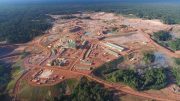Do you have a friend who’s so consistently late that you and your buddies always tell him to show up an hour before the real time he’s supposed to be there? Or a friend at parties who always ends up drinking more than he brings, so you and your buddies roll your eyes and always buy a little extra to stock the fridge?
In attending the recent Canadian Institute of Mining, Metallurgy and Petroleum convention in Toronto in early May, you definitely got the feeling that it’s finally dawned on mine operators and developers and their suppliers that they are one of those people, and only now are they seeing that several years ago their best friends stopped taking them seriously when it comes to their grand pronouncements on deadlines and budgets.
While the Prospectors and Developers Association of Canada convention in March had an overarching theme of junior companies dealing with an acute lack of financing, the CIM convention was suffused with new concerns about professional credibility in the face of several years of chronic project delays and cost overruns at new mine projects big and small, and far and wide.
Of course in the short-term, project overruns actually help suppliers and contractors fill their order books and wallets, so the CIM trade show floor wasn’t exactly a place where people were heard complaining about belt-tightening.
But this nagging feeling of waning credibility is getting harder to ignore for a group of people who consider themselves competent pragmatists who see it like it is, tell it like it is and get the tough jobs done.
Well, the reality is that over the past few years the capital costs of new mining projects have been coming in around 25% to 40% over the initial cost estimate, and we can all think of recent examples that are a lot worse.
Speakers and attendees at the CIM convention pointed to several trends that are contributing to this problem, or are generally just dogging the industry.
One is the increasing leanness of mining company staffing, which limits the miner’s ability to oversee the engineering, procurement and construction management contractor.
This problem may become acute just after an EPCM contractor hands over a turnkey project to the mining company to operate — a mine that may even have been built on time and on budget — but the miner doesn’t have the full range of technical competencies to run the mine optimally and profitably. Whose fault is that?
Another potential problem with an EPCM-contractor approach to mine building is the risk of a “silo effect” taking hold as subcontractors stick to their knitting and no one has the time, inclination or vision to keep seeing the big picture.
On top of that, many remote mine developments are increasingly glorified infrastructure-building exercises that are further and further away from the core competencies of a mining company.
While it’s clear that the costs of items such as tires and much mining equipment are starting to decline, many in attendance see first-hand that the cost of labour is definitely not coming down.
Nobody seems entirely satisfied with the human resources trends in the industry. Many point first to the growing age of senior managers at mine sites, with people in top positions frequently in their 60s and even 70s, and not a lot of experienced people in their 40s and 50s available to take over.
The workforce is aging in the trades, too, and several speakers argued for more encouragement of the trades (though, you get the impression they’d urge their own kids to head off to university.)
No surprise: there are continued difficulties in staffing remote mine sites, where fly-in, fly-out work rotations aren’t conducive to having a thriving family life, or are out of the question altogether for single parents. Is it time to go back to creating shiny new mining towns for workers, like in the 1950s and 1960s, or are those days gone forever?
Some see low-paid temporary foreign workers as a quick-fix staffing solution for remote mine sites, but that is becoming a political hot potato in Canada.
Other pressing topics at the convention dealt with the many tendrilled monster of corruption overseas; instilling a safety-first workplace culture in regions where it’s not ingrained; and creating global standards for all aspects of mine operations.





Be the first to comment on "Editorial: Be there at 7 and bring a six-pack"